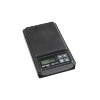Well most of us are not reloading in a lab. We are reloading in a home that has commercial wiring, and some of that wiring is old. Some commercial electronic items that we keep in our homes throw off surprising amounts of EMFs. An EMF detector can be purchased by anyone to find that out.
I worked in the EMC (electro-magnetic compatibility) field for 21 years, in compliance test labs that tested home, commercial, and industrial products - everything from electronic cigarettes to open-pit mining loaders and dump trucks.
Different products have to meet different standards, depending on the intended environment, and the possible consequences of their use. Generally, the home environment is considered to be less harsh than industrial or commercial environments. In other words, products intended for home use are expected to have less RF emissions than products intended for the other environments, but they are also usually tested to lower levels for susceptibility to interference. Sometimes the standards and test levels a product is tested to is listed in the manual or accompanying documentation. You might find a statement for either FCC or CE compliance (most products today are tested to both) and also which class. Class A is considered commercial/light industrial, Class B is considered residential.
I have three different electronic scales that I use - A $300 RCBS Chargemaster, a Frankford Arsenal DS750, and a $25 Gemini-20. I have tested them all with everything in my shop turned on, including 5 overhead 4-tube fluorescent fixtures. The only thing that I found in my shop that interfered with anything was my Milwaukee Li-Ion battery charger, and it only interfered with my FM stereo - a quick addition of a ferrite bead to the power cable fixed that. None of my electronic scales were affected.
I often see people say to buy LED lights instead of fluorescent due to possible EMI. Just because it is LED doesn't mean it doesn't give off EMI. The LED powered by a DC power supply and simple current limiting resistor is very benign, and that is what most people think of when LED is mentioned, but LED light fixtures/bulbs have switch mode power supplies that can give off EMI much like computer power supplies, so don't think just because it is LED that it can't interfere. I've tested some LED fixtures from a very well known LED manufacturer that initially failed the emissions limits, and with fixes it just barely passed. A lot of companies that mass produce an item are interested in making their product just good enough to pass, and that is all.
I'm sure if you did an EMI audit of your house, you would find dozens, maybe hundreds, of devices that give off EMI - anything electronic - that does not necessarily mean they will interfere with anything. Any product sold today has probably been tested to some standard for immunity from interference, and to levels that can be expected in the intended environment. But, just because they passed some standard, that only means that you have a
reasonable expectation that interference won't happen.
Having said all that, I know what the possibilities and consequences are with using electronic scales, and I use them anyway, even the cheap Gemini-20. But, that is just me.

I do highly recommend a good set of check-weights, though, even for balance beams.





